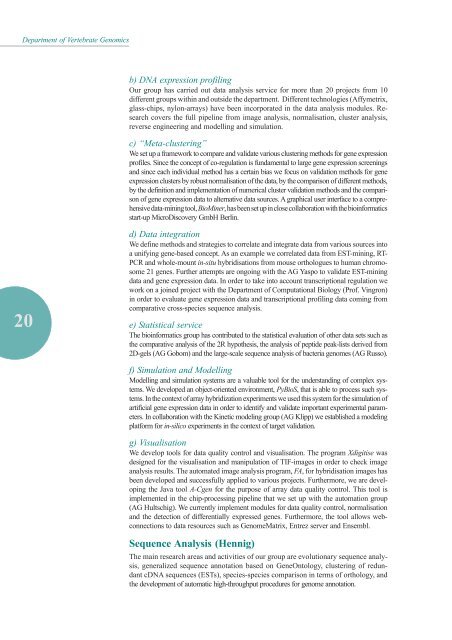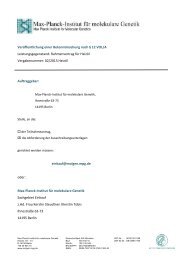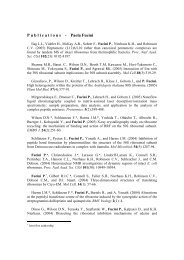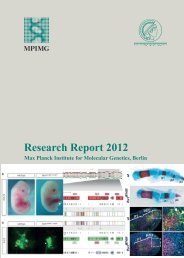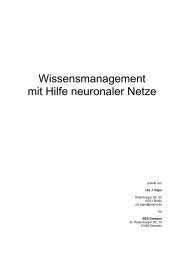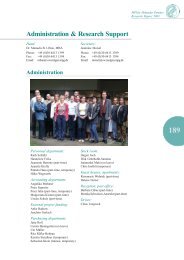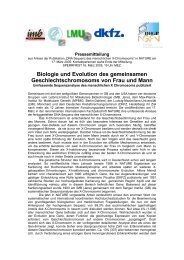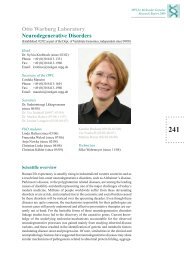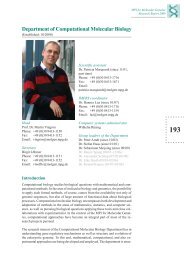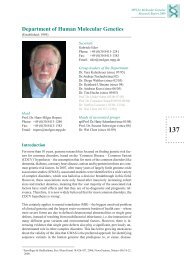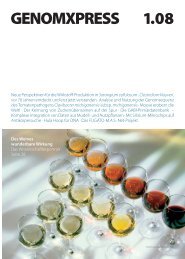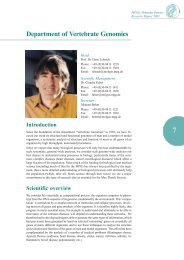Research Report 2003 - Max-Planck-Institut für molekulare Genetik
Research Report 2003 - Max-Planck-Institut für molekulare Genetik
Research Report 2003 - Max-Planck-Institut für molekulare Genetik
Create successful ePaper yourself
Turn your PDF publications into a flip-book with our unique Google optimized e-Paper software.
Department of Vertebrate Genomics<br />
20<br />
b) DNA expression profiling<br />
Our group has carried out data analysis service for more than 20 projects from 10<br />
different groups within and outside the department. Different technologies (Affymetrix,<br />
glass-chips, nylon-arrays) have been incorporated in the data analysis modules. <strong>Research</strong><br />
covers the full pipeline from image analysis, normalisation, cluster analysis,<br />
reverse engineering and modelling and simulation.<br />
c) “Meta-clustering”<br />
We set up a framework to compare and validate various clustering methods for gene expression<br />
profiles. Since the concept of co-regulation is fundamental to large gene expression screenings<br />
and since each individual method has a certain bias we focus on validation methods for gene<br />
expression clusters by robust normalisation of the data, by the comparison of different methods,<br />
by the definition and implementation of numerical cluster validation methods and the comparison<br />
of gene expression data to alternative data sources. A graphical user interface to a comprehensive<br />
data-mining tool, BioMiner, has been set up in close collaboration with the bioinformatics<br />
start-up MicroDiscovery GmbH Berlin.<br />
d) Data integration<br />
We define methods and strategies to correlate and integrate data from various sources into<br />
a unifying gene-based concept. As an example we correlated data from EST-mining, RT-<br />
PCR and whole-mount in-situ hybridisations from mouse orthologues to human chromosome<br />
21 genes. Further attempts are ongoing with the AG Yaspo to validate EST-mining<br />
data and gene expression data. In order to take into account transcriptional regulation we<br />
work on a joined project with the Department of Computational Biology (Prof. Vingron)<br />
in order to evaluate gene expression data and transcriptional profiling data coming from<br />
comparative cross-species sequence analysis.<br />
e) Statistical service<br />
The bioinformatics group has contributed to the statistical evaluation of other data sets such as<br />
the comparative analysis of the 2R hypothesis, the analysis of peptide peak-lists derived from<br />
2D-gels (AG Gobom) and the large-scale sequence analysis of bacteria genomes (AG Russo).<br />
f) Simulation and Modelling<br />
Modelling and simulation systems are a valuable tool for the understanding of complex systems.<br />
We developed an object-oriented environment, PyBioS, that is able to process such systems.<br />
In the context of array hybridization experiments we used this system for the simulation of<br />
artificial gene expression data in order to identify and validate important experimental parameters.<br />
In collaboration with the Kinetic modeling group (AG Klipp) we established a modeling<br />
platform for in-silico experiments in the context of target validation.<br />
g) Visualisation<br />
We develop tools for data quality control and visualisation. The program Xdigitise was<br />
designed for the visualisation and manipulation of TIF-images in order to check image<br />
analysis results. The automated image analysis program, FA, for hybridisation images has<br />
been developed and successfully applied to various projects. Furthermore, we are developing<br />
the Java tool A-Cgen for the purpose of array data quality control. This tool is<br />
implemented in the chip-processing pipeline that we set up with the automation group<br />
(AG Hultschig). We currently implement modules for data quality control, normalisation<br />
and the detection of differentially expressed genes. Furthermore, the tool allows webconnections<br />
to data resources such as GenomeMatrix, Entrez server and Ensembl.<br />
Sequence Analysis (Hennig)<br />
The main research areas and activities of our group are evolutionary sequence analysis,<br />
generalized sequence annotation based on GeneOntology, clustering of redundant<br />
cDNA sequences (ESTs), species-species comparison in terms of orthology, and<br />
the development of automatic high-throughput procedures for genome annotation.


